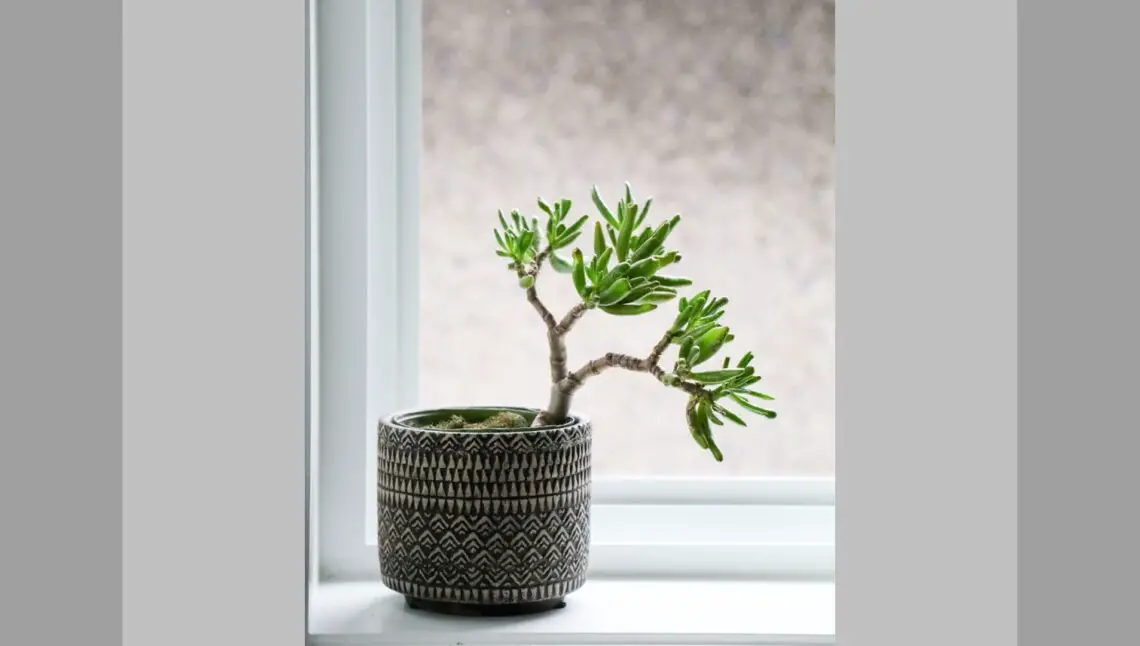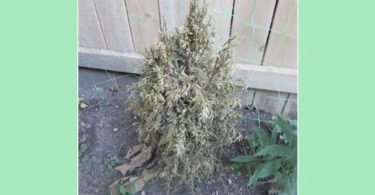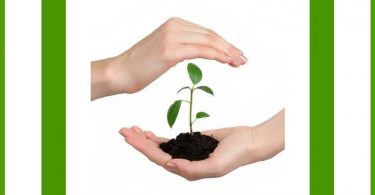Radko Tichavsky is a Czech born Mexican Agrohomeopath. He is a co-founder and director of Instituto Comenius in Mexico and author of Handbook of Agrohomeopathy, 2007 (Spanish) and Homeopathy for Plants, 2009 (Spanish), Organon de la Holohomeopatía and creator and teacher of Holohomeopathy.
He is now offering a one-semester virtual course in Holohomeopathy (in English). You can learn how to define and analyze holons and how to repertorize the specific homeopathic treatment beyond just disease or pest names. You can find out more here: www.icomenius.edu.mx
Many readers asked about Radko Tichavsky’s books. Below is a photo of them. They are available Spanish, Italian and Portuguese. For ordering or information: [email protected]
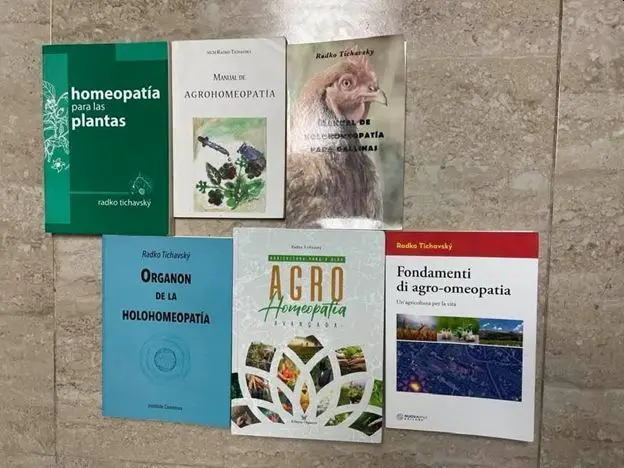
Editor’s Note: JT (Jenichen/Tichavsky) potency is centesimal dilution followed by 500 succussions or five hundred continuous turns with a wooden stick to the right and 500 turns to the left (if handling larger volume). The JT potency frequently has a better reaction in plants and it is very important in preparation of live bionosodes.
Dear Sir
Is there some relationship between companion planting and metabolic similarity?
Thank you
Aniruddha Patil
Radko Tichavsky:
Dear Aniruddha,
The holon is a living system, i.e. there are complex relationships between all living organisms including bacteria and fungi, also meso-organisms such as tardigrades, ciliates, amoebas, nematodes, and of course it also includes worms, termites, ants, spiders (macro-organisms), all of them. including plants, produce secondary metabolites that react and relate to each other.
The metabolic content of plants is highly dynamic not only in the amount of each metabolism expressed in different parts of the plant, but also has a temporality depending on the development of the life cycle and of course on the biotic and abiotic conditions of the plants.
In the coexistence of plants among themselves we can basically observe three types of relationships: plants that belong to the same family and therefore contain similar secondary metabolites, plants that do not belong to the same botanical family but contain an important number of common metabolites, and plants that coexist and complement each other, although they have few common secondary metabolites, mainly because they coincide in the same location and share common endophytic (fungi and bacteria) or surrounding organisms.
We can observe that the metabolic similarity of plants that do not belong to the same botanical family are the most important relationships for holohomeopathy, since they reveal that in the evolutionary past plants coexisted in similar conditions and elaborated similar metabolic responses. In these plants there is a balance between metabolic diversity (or metabolic complementarity) and similarity, an essential condition for metabolic communication between plants.
Many plants with metabolic similarity function very well as companion plants, and many companion plants have metabolic similarity, but not all. Thus we may find companion plants that have poor metabolic simplicity and plants with high metabolic similarity that perform poorly as companion plants.
In compatibility play a role not only the secondary metabolites of the plants (elaborated by the plant itself) but also the ability of the plants to host mutually beneficial edophyte organisms. Furthermore, there may be plants that in homeopathic preparation benefit from each other or from one or the other plant without reciprocity, but this does not mean that they can be good companion plants, e.g. due to too prominent and competitive root system behavior or parasitic habits, or competition for light or incompatible stature relation.
In summary, plants with metabolic similarity should not be confused or automatically designated as companion plants, in many cases they coincide but in others they do not.
Dear Dr. Tichavsky,
I’m in Victoria, Australia and my peach and nectarine trees are troubled by peach Leaf Curl, which is super common here (photo below). What is the solution to this problem?
The climate of Victoria is moderate and has four seasons. The summers are often warm and sunny. … Summer is from October to April with a maximum temperature of 25 degrees Celsius (77° Fahrenheit) and a minimum of 14 degrees (57°Fahrenheit). The average water temperature 22 degrees (71°F)
May is the wettest month with 68.0 mm (2.68 inch) of precipitation.
June is the driest month with 43.0 mm (1.69 inch) of precipitation.
average amount of annual precipitation is: 640.0 mm (25.20 inch
Mailing code is 3294
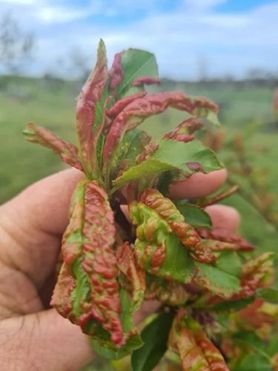
Thank you
Larry Kaminsky
Radko Tichavsky:
Hi Larry,
Peach leaf curl is caused by the ascomycota fungus Taphrina deformans. Peach and nectarine are natural bioaccumulators of copper and their copper deficiency is one of the causes of the presence of the disease, but it can be caused by different related abiotic factors, for example by high soil salinity or presence of other copper antagonistic heavy metals (e.g. cadmium, nickel or zinc).
It can be caused also by the negative effect of the application of some synthetic pesticides, or even insecticides considered ecological or environmentally friendly, such as pyrethroids. The fungus produces in the attacked leaves an increased amount of auxins, cytokinins and tryptophan causing an overproduction of anthocyanins in the leaves (producing the typical reddish color), which are formed as part of a defensive effort of the tree.
The fungus increases proline, ornithine and glycine in the leaves and causes an enormous hydration in the diseased leaves, which facilitates the proliferation of the fungus causing, first hypertrophy, and then death of the leaves, occasionally even affecting fruits.
While allopathic control strategies against this disease focus on mechanically adding different applications of copper, and have be repeated year by year with less efficacy and copper contamination of the soil, in holohomoeopathy the treatment consists of raising the epigenetic resistance of peach and nectarine trees on the one hand, and lowering the pathogenicity of the fungus or deactivating it with the presence of antagonistic microorganisms on the other hand.
One of the microorganisms useful in the control of this disease is Bacillus subtilis, a bacterium of the phylum Firmicutes that has the ability to inhibit the growth of the fungus T. deformans. The treatment is combined with Salix babylonica, made from the young branches or bark of the tree since salicylic acid is triggering and increases the systemic resistance of peach and nectarine trees to the fungus.
Holohomeopathic treatment consisting of live bionosode of Aloe vera 3 JT and Salix babylonica 3 JT should be applied in January, or at the latest in the first half of February. Two or three repeated applications should be made at an interval of one week. Applications should be sprayed on and around the trees using 500 liters of homeopathic application per hectare.
Alternatively, treatment can be done with the live bionosode of Bacillus amyloliquefasciens, a beneficial bacterium found in the root system of many plants, most easily obtained from the roots of Hedera helix. First a little of the root of the plant is separated and washed with a brush and a stream of water to remove fungi and pathogenic bacteria from its exterior, then the root is immersed for 2 minutes in ethyl alcohol at 70%, and again washed with water to remove the remains of alcohol.
Then the root is placed in a blender along with a liter of carbonated water (water with CO2) and liquefied. After filtering, live bionosode is prepared in non-chlorinated water at 4 JT power in the dynamization process, i.e. dilution of 1:100 followed by 500 vigorous successions, when the volume of the preparation increases, the successions are replaced by 500 turns to the right and 500 turns to the left carried out with a wooden stick. The dosage is 500 liters per hectare sprayed in the form of very fine droplets, which when sprayed form a kind of mist. Bionosode is applied three times, a week apart in January and at the beginning of February on the soil and on the trees.
Dear Mr. Tichavsky.
I’ve got Black Spot on my rose bushes. Is there a holistic solution? I live in Miami, Florida. Rainfall is about 60 inches/year. The climate is tropical. Warm winters and long and damp summers. The average temperature ranges from 20 °C (68 °F) in January to 29 °C (84 °F) in July and August. Postal code 33126.
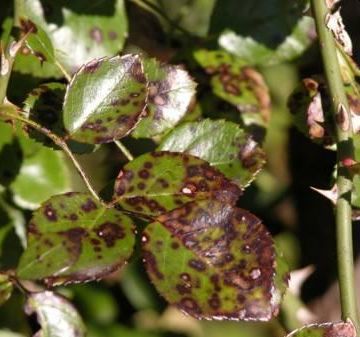
Thank you
Eleanor
Radko Tichavsky:
Dear Eleanor,
Diplocarpon rosae is a pathogenic fungus belonging to the ascomycota, common on roses and known as “Black Spot”. Treatment with Sulphur 6 CH or Silicea terra 6 CH can help solve the problem temporarily, but it often returns and becomes chronic, especially if the roses are planted in soils with poor drainage and poor air circulation between plants due to the high density of roses.
Cinnamomum verum 4 CH is also a very useful homeopathic remedy although some strains of Diplocarpon rosae may show resistance to it. Tetraploid roses (with four copies of DNA) are known to be resistant to this disease. Therefore, polyploidization of plants, a treatment that causes the plant to multiply the number of DNA copies in its genetic structure, e.g. by repeated application of Colchicum autumnale at 6 CH potency, increases the resistance of roses to black spot.
Carica papaya latex 6 JT is another excellent homeopathic remedy containing. Chitinase, a decomposing enzyme, is a protein constituent of many fungi. Chitinase in the soil increases the availability of nitrogen in plants and carbon in the soil, necessary for the multiplication of bacteria antagonistic to this pathogenic fungus such as Pseudomonas fluorescens (commonly present in Lentinula edodes – shiitake funghus) and Bacillus subtilis (present in the gel of Aloe vera leaves).
It is important to apply these two live bionosodes in the correct order, i.e. first apply live bionosode of Lentinus edodes on the soil around the roses, and a week apart apply the live bionosode of Aloe vera (made from the gel of the leaves) both remedies have to be applied at 3 JT potency.
The Pseudomonas spp. (Gammaproteobacteria) and Bacillus spp. (Firmicutes) are two families of bacteria that antagonize each other and even can kill each other. Pseudomonas live deep in the soil and Bacillus live at the soil surface or very close to it. For this reason the Pseudomonas bionosode is applied first and then the Bacillus living bionosode is applied and not vice versa
The Bacillus at the soil surface make nitrogen available, promote plant growth but also produce exudates that once leached (washed with the irrigation or rain water) deep in the soil nourish the Pseudomonas that live deep in the soil. Pseudomonas, on the other hand, makes mineral micronutrients bioavailable from the soil to the plants and facilitate formation of biofilms. In this way one group of bacteria correctly benefits the other, and both are responsible for nourishing and protecting the plants of the rose.
Dear Prof. Tichavsky,
We live on 100 acres in the Hunter Valley in Australia. We’re developing our farm using permaculture principles and, in particular, are using living mulches. I’ve recently discovered agrohomeopathy after using homeopathy for ourselves and our pets for a few years. I’m wondering about remedies for aphids on brassicas. We’re using BQ (brassica) mulch, amongst other green manures / living mulches and our BQ mulch has aphids on it. The climate is like a Mediterranean climate. In summer the average daily temperature is between 28°-30C and in winter 16-18°C, dipping to lows of 2-4°C overnight. Annual rainfall averages 870 mm. Postal Code 2280
Thank you
Richard Kline
Radko Tichavsky:
Hello Richard,
Although holohomeopathy has some common points with permaculture, the main difference between the two methods is that permaculture requires a large amount of inputs produced or managed by humans and must be constantly added to the system to make it work, ie it is an input-based agriculture, while holohomeopathy is a method based on process agriculture, rather than adding large amounts of inputs, it affects the existing or emerging processes in the holon, promoting self-regulation mechanisms.
Although both methods claim to be sustainable, it is a fact that crops dependent on human-provided inputs are not completely sustainable, when the amount of inputs decreases and rapidly decline in fertility without human intervention, while holohomeopathic crops, once a state of equilibrium is reached (usually after 1-3 years of holohomeopathic interventions) remain stable, even after being abandoned by humans and without the need for additional inputs.
The transition process from input based to the process-based agriculture depends on the biotic or abiotic conditions in the holon, i.e. on the fragmentation or scarcity of the connected biodiversity among micro-, meso- and macro-organisms in the soil on the one hand, and on the other hand on climatic or soil conditions (e.g. degree of desertification, presence of heavy metals or high salinity).
In this sense, the management of living cover crops such as BQ, allopatically defined as “biofumigants” used for the suppression of for example Sclerotinia sclerotiorum, Sclerotium rolfsii, Macrophomina phaseolina and Rhizoctonia solani, Fusarium, Phytophthora, Pythium, Verticullium and Root-knot nematodes (Meloidogyne spp.) are the expression of a fragmented, input-based concept.
That is, they solve some problems, enrich the availability of nitrogen in the soil, lower the soil pH, decompose the soil, function as biofumigants for some pathogens, especially fungi, and reduce the presence of phytopathogenic nematodes, but when applied as a monoculture, they cause other imbalances, including cadmium accumulation.
They cause a considerable decrease in mycorrhization, since brassicaceae are non-mycorrhizal plants antagonistic to the endomycorrhizal fungi and vascular arbuscular mycorhiza (VAM) and consequently low resistance to high temperatures, low resilience to water stress (lack of water) in crops established after this Brassicaceae cover crop and the mentioned presence of aphids for example.
Rather than palliating aphids by means of homeopathy, it is important to understand the challenge of connected biodiversity in the holon. In nature, Brassicaceae rarely appear alone in monoculture, they are always present together with other plant families (e.g. Poaceae, Fabaceae).
A solution is to stop using Brassicaceae monoculture and to formulate a more biodiverse and balanced intercrop cocktail, where Brassicaceae do not represent more than 30% of the total biodiversity in the cover crop, Solanaceae, Poaceae, Fabaceae, Alliaceae, Asteraceae, Apiaceae, Lamiaceae for example, and some plants especially important as repellents or non-hosts of aphids such as Tanacetum vulgare, Artemisia absinthium, for example. Brassicaceaes are natural bioaccumulators of nitrogen and represent powerful olfactory stimuli (volatile secondary metabolites), colors and shapes attraction for aphids.
Coccinella septempunctata, Harmonia axyridis or other aphid predators will appear as long as there is a greater biodiversity of Asteraceae in the cover crop, as will Aphidius colemanii and other parasitoids, in addition you can apply live bionosodes of enthomopathogenic bacterium Bacillus thuringuensis and entomopathogenic fungus Bauveria bassiana, all organisms together will help to rebuild biodiversity in biodiverse cover crops and choose a balanced and resistant holon.
In summary: I suggest you increase cover crop biodiversity, apply live bionosodes of mycorrhizal fungi and VAM (e.g. those elaborated from the root system of native plants and trees in the holon) always at low potency (e.g. 3-4 JT) dosing an application of 50 liters per hectare and applied in the wet period of the year. It is important to reduce soil tillage to the minimum possible and after cutting the green cover let it decompose on the surface without incorporating it into the soil.
Greetings Radko,
We’re transplanting some perennials. Is Silica the best remedy to use for shock and faster rooting? How do I administer it?
Thank you
Anna
Radko Tichavsky:
Dear Anna,
To be able to answer the question correctly I would need to know the species of the plants you transplant, since there is nothing like an “infallible and universal remedy for the transplant of any species of plant”, although I know that there are authors of over simplified books of homemade agrohomeopathy that claim so. There is no scientific evidence of it and will not exist in the future, due to the great metabolic variety of plants.
I can mention that the process of cell differentiation popularly called rooting depends mainly on the presence of certain elements and shortage of others, for example, in general, substrates very rich in nitrogen are not prone to generate a good rooting, but on the contrary, high carbon substrates are well drained, for example, soils mixed with some river sand and with some nitrogen deficiency are excellent for stimulate rooting of plants.
Secondly, the differentiation of root tissues and their growth is stimulated by the presence of certain hormones, for example auxins, indolacetic acid, indolbutiric acid or gibberellins are the most commonly used. These hormones are temporarily produced during germination of seeds e.g. lentil, soybean, or wheat.
You can make a germination at home, then when the seedlings reach one week of age you mix the seedlings with everything and the leaves and roots in a blender in one liter of carbonated water (not chlorinated) and make a low potency homeopathic preparation e.g. 2-4 JT in non-chlorinated water and apply in irrigation immediately after transplanting.
As an adjuvant we apply in the cocktail a small piece of fresh potato or a bit of banana peel. In this way in this live bionosode will be present bacteria producing growth hormones that will stimulate rooting after transplanting. It is also important during transplanting not to expose the roots to the air for too long, as the air in the concentration we breathe is toxic to most plant roots.
The homeopathic remedies of homeopathic pharmacy that are related to good rooting are for example Sulphur, Calcarea carbonica, Carbo vegetabilis Ruta graveolens, Calendula officinalis, Arnica montana, Zincum metallicum, Salix babylonica, Solanum tuberosum radix, Staphysagria, but with the limitations as I mentioned on.
Hello Mr. Tichavsky,
Our pear trees have come down with something unsightly! The orange mark is quite hard and tough on the underside of the leaf. Is it a fungus of some kind? (see pic below)
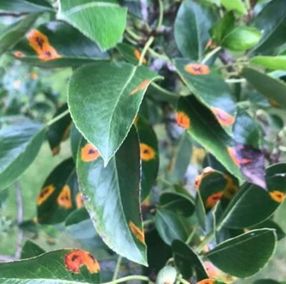
Thank you
Neal Thompson
Radko Tichavsky:
Dear Neal,
The condition of your pear trees is caused by the presence of Gymnosporangium sabinae (belonging to the Uredinales fungi), rust disease, a basidiomycete fungus that is often associated with other fungi Giberella lateritia and Cladosporium herbarum.
This fungus usually resides on Juniperus sabina and other Juniperus sp. species. Cedar trees infected with the fungus up to a distance of 300 meters can transmit the spores by wind and mists. The spores are usually discharged in late April and protection against them is created by applying colloidal Sulphur at 4 JT potency alternating with homeopathic application of colloidal copper, Cuprum metallicum colloid at 4 JT potency. Both remedies are used with a few drops of Thymus vulgaris essential oil as an adjuvant. Equisetum hyemale 6 JT, Silicea terra 6 JT and essential oil of Thymus vulgaris 6 JT can also be useful.
[hr]
Dear Sir,
I am a farmer from India and a small practitioner of homeopathy. I treat myself, my family and close friends who trust me. Basically from an agriculture background. I own 25 acres of land. I want to use homeopathy in agriculture and want to study its effectiveness.
We have limited literature on agrohomeopathy I kindly request you to please share your knowledge and guide us on how to increase soil fertility. In my area we use lots of pesticides and germicides to control pests (caterpillars).
I belong to south India, Sedam, District, Gulbarga, Karnataka state. The climate here is tropical. In winter, there is much less rainfall than in summer. Kalaburagi, the wet season is oppressive and overcast. The dry season is mostly clear, and it is hot year round. Over the course of the year, the temperature typically varies from 64°F to 103°F and is rarely below 58°F or above 108°F. The rainfall here is around 838 mm | 33.0 inch per year.
May is the warmest month of the year. The temperature in May averages 37.1 °C . In December, the average temperature is 23.3 °C | 73.9 °F. It is the lowest average temperature of the whole year.
Thank you
Shankar Kodampur
RadkoTichavsky:
Dear Shankar,
In the climatic conditions of the place where you live you should be concerned about how to increase the capacity of the soil to hold and store water. The first important condition is to keep the soil covered either with a dry mulching or green intercrop mulching of the soil.
In this way the evaporation of water from the soil decreases. Remember that both fungi and beneficial bacteria require water to live. Second tip, look at the plants native to your holon, the cacti or succulents or even plants that are not but maintain a vigorous appearance even in drought conditions. These plants have learned to collaborate with fungi called VAM (vascular arbuscular mycorrhiza) that produce growth hormones inside the plants and increase their resistance to water stress (drought).
Extract some roots from these plants, wash them well in water with a brush, then let them soak for two minutes in a little alcohol and wash them again in tap water. Then put a liter of carbonated water in a blender, cut the roots into small pieces and blend them well. Filter the content and the liquid you have obtained dynamize it at 1 JT power. Dilute this liquid (1 liter) in 100 liters of non-chlorinated water and make 500 turns with a wooden stick to the right and five hundred turns to the left and apply on the soil by spraying.
In this way you will apply live bionosode of VAM fungi and beneficial bacteria on your cultivated plants. For the cultivation of herbaceous plants you can look for wood-decomposing fungi of the Ganoderma family, which look like small plates attached to the trunks of living or dead trees. You chop the mushrooms (about 250 grams) and place them in 100 liters of water for about 24 hours. Then put 1 liter of this liquid for each 100 liters of irrigation water adding Opuntia ficus indica sap and make 500 vigorous turns with a wooden stick to the right and to the left. You apply this preparation on the soil. They contain laccase, cellulose, hemicellulose and lignin decomposing enzymes that become (once decomposed) an excellent food for beneficial bacteria in the soil.
This bionosode should not be applied in tree crops, it is only suitable for herbaceous plants. As far as the soil is concerned the live bionosode of Ganoderma spp. will sponge the soil and make it softer for the plants and will decrease your need to turn over the soil layers. In this way you will gradually build up soil fertility.
If you use cow dung as a fertilizer you can decrease its amount as its application eliminates the nitrogen fixing bacteria in the soil. Take the time to read not only this column but past columns as you will find a lot of valuable information for small farmers.
The holohomeopathic method is especially useful in low-cost agriculture, since it does not require the purchase of inputs (practically all are available in nature around you). Observe plants that never get sick or are not visited by pests, prepare homeopathic remedies from them and spray on crop plants. As a result, you will see a significant decrease of pests and diseases in the crops and an increase of fertility in the crops.
Remember that the process of bioremediation through homeopathy typically requires one to three years, patience and assiduity, a lot of observation of nature and finally a little of knowledge.



